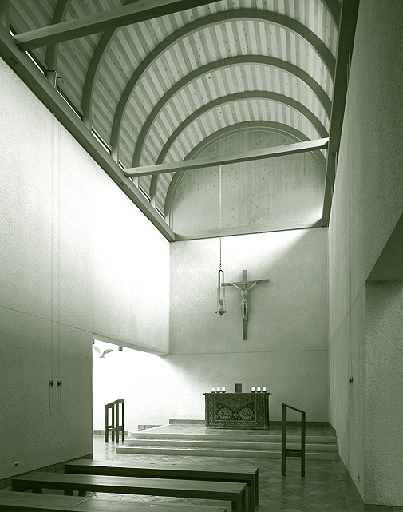
Named for the quiet believer who, witnessing Jesus’s crucifixion, boldly took down the tortured body to protect it from further desecration, the St. Joseph of Arimathea chapel in Berkeley is a small, unassuming structure, within which are found exquisite moments of beauty and strength.
The chapel, built in 1975, functions as the nucleus of the St. Joseph of Arimathea Anglican Theological College. Bishop Morse, who commissioned architect William Dutcher to design the chapel, continues to oversee the seminary’s service to the Anglican Province of Christ the King.
Flanked by what look to be fraternity houses (the more pristine of which is actually the seminarians’ living quarters) on the busy intersection of Durant and Bowditch, the chapel easily goes unnoticed. It is only upon rounding in toward the recessed entrance that a crucifix and bright Byzantine door come into view, and the vaulted roof is hinted at behind the rust-toned stucco exterior.
In response to its situation amidst the bohemian buzz of Berkeley, the chapel conceals itself from casual passersby. The plain exterior wall protects its traditions—both liturgical and aesthetic. Indeed, Bishop Morse proudly touts his seminary as “Fort Defiance”—St. Joseph’s belongs to a diocese that holds firm to religious roots in an ever-changing cultural climate. The Bishop says he doesn’t have a problem with people not accepting this faith (he jokes that they might even get to heaven faster!), but if they are going to accept it, they must accept every aspect of it wholly—not change it or water it down to make it more palatable.
This is an environment built to support those who dedicate their lives to one eternal faith— and thus to experience the chapel requires commitment. It is impossible to glean anything from outside. To know the chapel’s beauty, one must enter into the building fully, bodily—to listen to the choir sing in Latin, see the beams of sunlight stream into the room, and smell the incense.
The front doors of the chapel enter into a narrow narthex, its only adornment an image of the Madonna and Child by a famed Russian iconist in the tradition of “Our Lady of Vladimir.” From the narthex, the nave opens fifty feet long and twenty feet wide, crowned by a vaulted ceiling with low clerestory windows. The wood slats of the ceiling are stained in alternating red tones that complement the warmly patterned tile floor. It is the ceiling that the music director Robert Melhuish credits for the chapel’s near-perfect acoustics.
A beautifully crafted, pale wood organ, on long-term loan from UC Berkeley, so dominates the west end of the nave that it appears at first to be built in. Against the opposing east wall, the altar is raised three steps, with a single candle suspended from the ceiling and a crucifix on the wall.
The weather-worn wooden crucifix was carved 400 years ago by an unknown German peasant and brought to the chapel by a friend of Bishop Morse. The crucifix’s understated beauty—and simultaneous authority as the only icon adorning the nave—makes it a dramatic presence.
Four backless wooden pews are set up for services. It is then, sitting among an intimate group of believers, that the sensory promises of this small chapel are realized. During daytime prayers and Mass, incense dances through the shards of light that pierce through the clerestory windows. At candle- lit evening Compline services, St. Joseph’s celebrated acoustics carry the soaring voices of the choir, followed by a featured musician on the organ, guitar or other instrument.
The beauty of St. Joseph of Arimathea is not apparent from the outside. There are no steeples or stained glass windows or ornate trimmings—and it is precisely such a seeming lack of design on the exterior that makes the interior so powerful. Like the linen-lined tomb in which St. Joseph of Arimathea laid the body of Jesus to rest, the St. Joseph of Arimathea chapel is designed wholly for the people who enter into it.
Author Amber Whiteside holds a BA in Religious Studies from Whittier College and a Master of Visual Criticism from California College of the Arts.
Originally published 4th quarter 2003, in arcCA 03.4, “Reflect Renew.”






